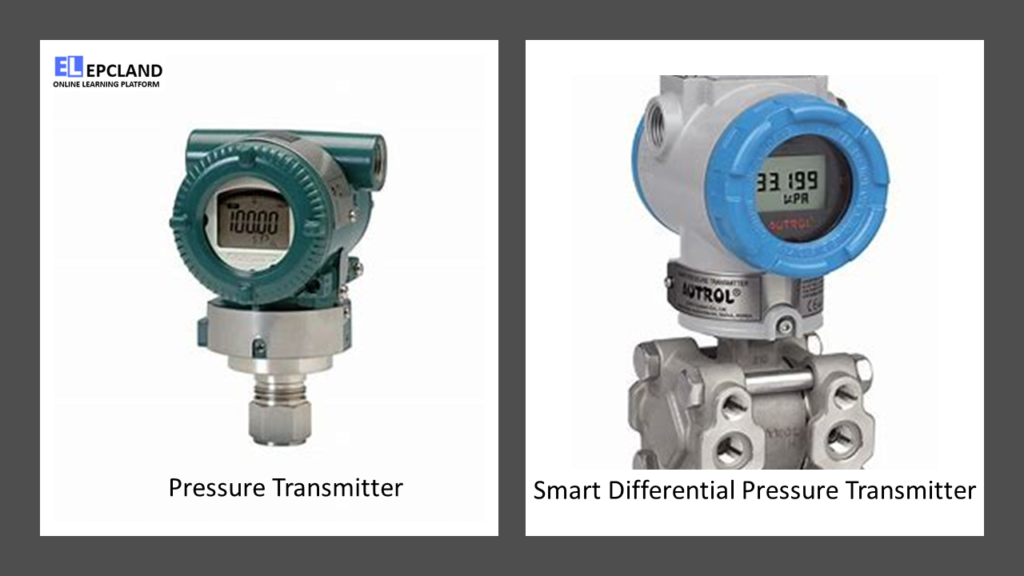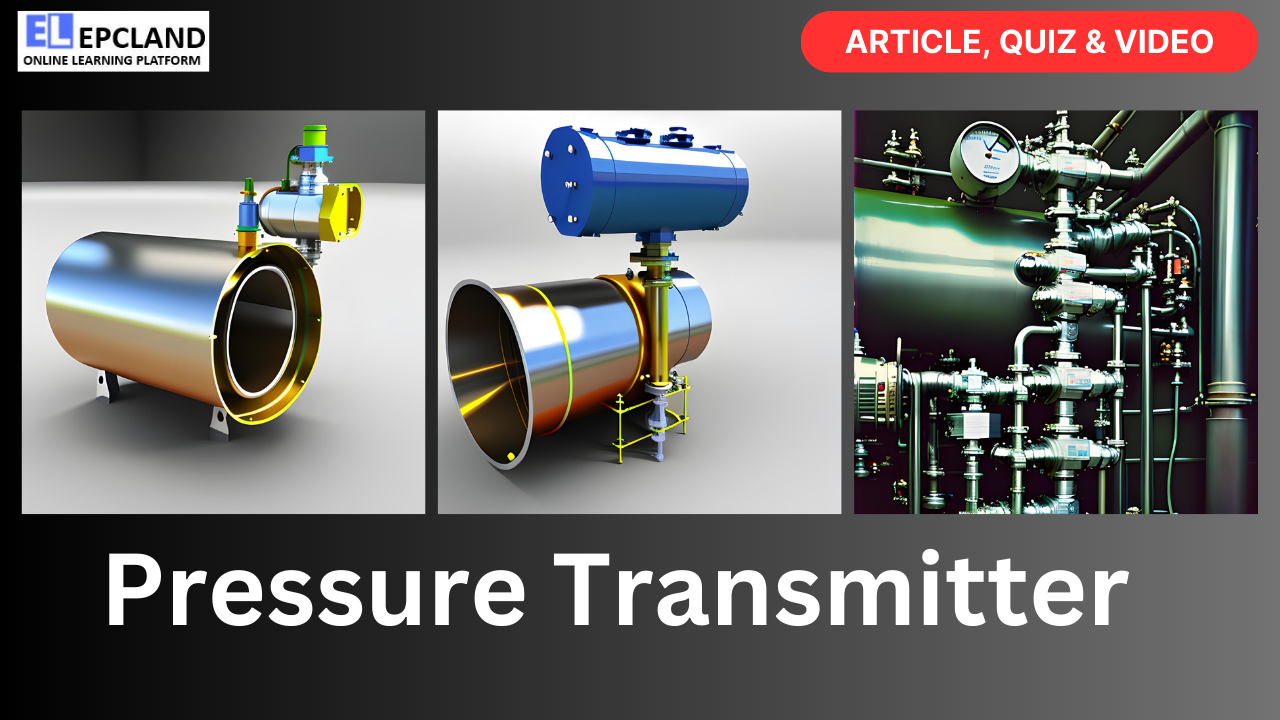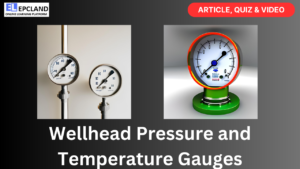Pressure transmitters are integral components of industrial processes, functioning as vital tools for accurate pressure measurement and control. In the dynamic world of process control, where precision is paramount, these devices stand as the cornerstone, enabling industries to maintain safety, efficiency, and quality across a spectrum of applications. This section delves into the essence of pressure transmitters, elucidating their significance and the critical role they play in various industries.
Table of Contents
Don’t miss the Complete Course on Piping Engineering: Check Now
By EPCLand.com
Defining Pressure Transmitters and Their Significance
Pressure transmitters, often referred to as pressure transducers or pressure sensors, are instruments designed to convert physical pressure into an electrical signal. This transformation allows for easy measurement, monitoring, and integration of pressure data into various control systems. From the oil and gas sector to manufacturing and beyond, pressure transmitters offer insights into processes that involve liquids, gases, and vapors, ensuring optimal performance.
The Role of Pressure Measurement in Industrial Processes
Pressure is a fundamental parameter governing the behavior of fluids within closed systems. In industries spanning from petrochemicals to pharmaceuticals, the ability to accurately measure and control pressure is paramount for safety, efficiency, and regulatory compliance. Pressure transmitters provide a means to capture the dynamics of pressure changes, offering a window into the health and performance of processes.
By offering real-time pressure data, pressure transmitters enable industries to make informed decisions, optimize process efficiency, and prevent catastrophic failures. In the oil and gas sector, for instance, pressure transmitters play a pivotal role in monitoring wellhead pressures, ensuring that extraction operations proceed safely. In manufacturing, pressure transmitters aid in maintaining consistent product quality by controlling pressure levels in various stages of production.
In essence, pressure transmitters serve as the eyes and ears of industrial systems, allowing engineers and operators to perceive the often invisible yet critical force of pressure. Their data-driven insights empower industries to maintain control, uphold safety standards, and drive productivity.
Stay tuned as we dive deeper into the working principles of pressure transmitters, exploring the mechanisms that enable them to convert pressure into meaningful electrical signals.
Working Principles of Pressure Transmitters
Pressure transmitters operate based on the fundamental principles of pressure sensing and signal conversion. These devices employ intricate mechanisms to translate the physical force of pressure into electrical signals that can be easily processed and interpreted. This section delves into the working principles that underlie the functionality of pressure transmitters.
Understanding the Principles of Pressure Sensing
At the core of every pressure transmitter lies a sensing element that reacts to changes in pressure. This sensing element is designed to deform or change its characteristics in response to the applied pressure. Common sensing technologies include piezoelectric, strain gauge, and capacitive sensing.
Piezoelectric Sensing: In piezoelectric pressure transmitters, certain materials generate an electrical charge when subjected to mechanical stress, such as pressure. This generated charge is then converted into a proportional voltage signal that represents the applied pressure.
Strain Gauge Sensing: Strain gauge pressure transmitters utilize a small, flexible wire or film that changes resistance when subjected to strain. As pressure causes the sensing element to deform, the resistance of the strain gauge changes, leading to a measurable change in electrical resistance.
Capacitive Sensing: Capacitive pressure transmitters rely on changes in capacitance between two plates as pressure alters the distance between them. This change in capacitance is translated into an electrical signal that corresponds to the pressure applied.
“Pressure transmitters, the unsung heroes of industrial systems, translate the language of forces into the poetry of data, enabling machines to whisper their stories of fluid dynamics and process control with remarkable precision.”
By EPCLand.com
Conversion of Pressure to Electrical Signals: The Heart of the Transmitter
Once the pressure-induced changes in the sensing element are captured, the pressure transmitter proceeds to convert these changes into electrical signals that can be easily transmitted and analyzed. This conversion involves several stages, including signal conditioning and amplification.
Signal Conditioning: The raw electrical signals from the sensing element often require conditioning to ensure accuracy and stability. Signal conditioning involves processes such as filtering out noise, linearization of non-linear responses, and temperature compensation.
Amplification: Amplification is the process of increasing the magnitude of the electrical signals. This is particularly important when dealing with weak signals generated by the sensing element. Amplification enhances the signal’s strength, making it suitable for further processing and transmission.
Pressure transmitters are designed to provide accurate and reliable readings across a range of pressures and temperatures. By understanding these underlying principles, we can appreciate the intricate mechanisms that allow pressure transmitters to capture the dynamic force of pressure and translate it into meaningful data. In the next section, we will explore the different types of pressure transmitters available and the factors that guide their selection for specific applications.
Types of Pressure Transmitters
Pressure transmitters come in various types, each designed to cater to specific applications and measurement requirements. The choice of pressure transmitter type depends on factors such as the nature of the pressure being measured, the environment in which it operates, and the level of accuracy required. In this section, we will explore the different types of pressure transmitters and their distinctive features.

Absolute, Gauge, and Differential Pressure Transmitters: Key Differences
- Absolute Pressure Transmitters: Absolute pressure transmitters measure pressure relative to a perfect vacuum. They include the atmospheric pressure in their measurement. These transmitters are suitable for applications where knowing the exact pressure above absolute zero is critical, such as high-altitude testing or vacuum applications.
- Gauge Pressure Transmitters: Gauge pressure transmitters measure pressure relative to atmospheric pressure. They do not account for atmospheric pressure in their readings. These transmitters are commonly used in applications where pressure variations from ambient conditions are of interest, such as tire pressure monitoring or hydraulic systems.
- Differential Pressure Transmitters: Differential pressure transmitters measure the difference in pressure between two points. They are often used to monitor pressure drops across filters, measure flow rates, or control levels in tanks. Differential pressure transmitters provide insights into the flow or pressure changes within a system.
Selecting the Right Type for Different Applications
The selection of the appropriate pressure transmitter type depends on the specific demands of the application. For instance, in a chemical processing plant, gauge pressure transmitters might be used to monitor pressure variations in reaction vessels, ensuring that pressure remains within safe operating limits. On the other hand, differential pressure transmitters could be employed to measure pressure drops across filters to assess their efficiency.
In industries where altitude variations are significant, such as aviation, absolute pressure transmitters play a crucial role in providing accurate readings despite changes in atmospheric pressure. These transmitters ensure that critical systems operate within safe pressure ranges.
Ultimately, the choice between absolute, gauge, or differential pressure transmitters hinges on the nuances of the application, including the intended use, environmental conditions, and the desired level of precision. In the following section, we will explore the components and construction of pressure transmitters, shedding light on the intricate design that enables these devices to perform reliably in diverse settings.
Components and Construction
Pressure transmitters are intricate devices that comprise various components working in harmony to ensure accurate pressure measurement and reliable signal transmission. The design and construction of pressure transmitters are tailored to withstand harsh industrial environments while delivering precise data. In this section, we will delve into the core components and construction considerations of pressure transmitters.
Core Components: Sensor, Electronics, and Housing
- Sensor: At the heart of every pressure transmitter lies the sensing element responsible for detecting pressure changes. The selection of the sensing technology—such as strain gauges, piezoelectric crystals, or capacitive elements—dictates the sensitivity, accuracy, and range of the transmitter.
- Electronics: The electronics of a pressure transmitter are responsible for signal conditioning, amplification, and conversion. They process the raw electrical signal from the sensor, apply corrections for temperature and nonlinear behavior, and prepare the signal for transmission to control systems.
- Housing: The housing of a pressure transmitter serves as its protective shell, safeguarding the sensitive internal components from environmental factors. The housing is designed to withstand harsh conditions, such as temperature extremes, humidity, and exposure to chemicals.
Don’t miss the Complete Course on Piping Engineering: Check Now
By EPCLand.com
Materials and Design Considerations for Various Environments
Pressure transmitters are deployed in a diverse array of environments, from offshore oil rigs to chemical processing plants. As a result, the choice of materials and design features is essential to ensure the longevity and accuracy of the device.
- Materials: Pressure transmitter components are often crafted from materials like stainless steel, which resists corrosion and is suitable for applications involving liquids or gases. In aggressive environments, specialized coatings or materials may be used to enhance resistance to chemicals and abrasive substances.
- Sealing and Encapsulation: To protect internal electronics and sensor elements from moisture, dust, and contaminants, pressure transmitters are sealed using gaskets, O-rings, or potting materials. This encapsulation prevents ingress and maintains the integrity of the device.
- Mounting and Connection: Pressure transmitters are designed with various mounting options to accommodate different installation scenarios. Mounting methods include direct attachment to pipelines, flanges, or brackets. Connection types range from threaded fittings to flanges and sanitary connections.
The interplay of these components and design considerations ensures that pressure transmitters are reliable, accurate, and suitable for a range of demanding applications. In the upcoming section, we will explore the diverse applications of pressure transmitters across various industries, shedding light on their invaluable contributions to process control and safety.
Applications of Pressure Transmitters
Pressure transmitters find extensive applications across a spectrum of industries, where the accurate measurement and control of pressure are paramount for efficient and safe operations. From oil and gas exploration to pharmaceutical manufacturing, pressure transmitters play a pivotal role in ensuring process stability, quality, and compliance. In this section, we will delve into the diverse applications of pressure transmitters in various sectors.
Oil and Gas Industry: Monitoring Wellhead Pressure and Pipeline Flow
In the oil and gas sector, pressure transmitters are instrumental in maintaining the integrity of wellheads and ensuring the efficient transport of hydrocarbons through pipelines. Pressure transmitters located at wellheads provide real-time insights into pressure variations, allowing operators to prevent blowouts and ensure the safety of extraction operations. Along pipelines, pressure transmitters monitor flow rates and pressure levels, aiding in the detection of leaks and optimizing the transportation of oil and gas.
Manufacturing Processes: Ensuring Consistency and Quality
Pressure transmitters are indispensable in manufacturing industries, where precision and consistency are essential. In industries such as automotive manufacturing, pressure transmitters monitor hydraulic systems to ensure proper functioning of machinery. Additionally, pressure transmitters are utilized in injection molding processes to control pressure during plastic molding, ensuring product quality and reducing defects.
Pharmaceuticals and Chemicals: Precise Pressure Control in Reaction Vessels
In pharmaceutical and chemical manufacturing, pressure control is critical to achieving desired reaction outcomes. Pressure transmitters enable precise monitoring and adjustment of pressure within reaction vessels, ensuring reactions proceed as intended. Whether synthesizing pharmaceutical compounds or producing specialty chemicals, pressure transmitters contribute to product quality and yield.
HVAC and Building Automation: Balancing Air Pressure
Pressure transmitters are used in heating, ventilation, and air conditioning (HVAC) systems to monitor and control air pressure. These transmitters help maintain optimal indoor air quality by ensuring proper airflow and pressure differentials in various zones of buildings. By preventing pressure imbalances, pressure transmitters enhance comfort and energy efficiency.
Aerospace and Aviation: Maintaining Cabin Pressure
Pressure transmitters are crucial in aerospace applications, particularly in aircraft cabin pressure control. These transmitters help maintain a safe and comfortable cabin environment at high altitudes. By continuously monitoring cabin pressure and adjusting it as needed, pressure transmitters contribute to passenger well-being during flights.
From enabling safe oil extraction to optimizing chemical reactions, pressure transmitters serve as indispensable tools across industries. Their ability to provide real-time pressure data empowers industries to maintain operational excellence, ensure product quality, and enhance safety. In the next section, we will delve into the importance of calibrating pressure transmitters for accurate and reliable measurements.
Calibration and Accuracy
The accurate measurement of pressure is the bedrock of reliable process control, and this accuracy hinges on the calibration of pressure transmitters. Calibration is the process of verifying and adjusting the output of a pressure transmitter to align with known reference standards. In this section, we will explore the necessity of calibration for pressure transmitters and the procedures involved in ensuring accurate measurements.
Necessity of Calibration for Accurate Pressure Measurement
Over time, factors such as sensor drift, environmental conditions, and wear can affect the performance of pressure transmitters. Calibration serves as a corrective measure to mitigate these effects and maintain the accuracy of measurements. Accurate pressure readings are crucial for making informed decisions, optimizing processes, and ensuring the safety of operations.
Calibration Procedures and Standards for Pressure Transmitters
Calibrating a pressure transmitter involves comparing its output to a known reference standard across a range of pressure values. The calibration process varies depending on the type of pressure transmitter and the application. Calibration can be performed using deadweight testers, pressure comparators, or automated calibration systems.
Industry standards, such as those set by organizations like the International Organization for Standardization (ISO) and the American National Standards Institute (ANSI), provide guidelines for pressure transmitter calibration. Calibration procedures include adjusting the transmitter’s output to match the reference standard’s values and recording the calibration results for documentation.
Regular calibration intervals are determined by factors such as the criticality of the application, the environment in which the transmitter operates, and regulatory requirements. By adhering to proper calibration practices, industries ensure that their pressure transmitters provide accurate and reliable measurements throughout their operational lifetimes.
In the subsequent section, we will delve into the proper installation techniques and ongoing maintenance considerations that contribute to the optimal performance of pressure transmitters in various applications.
Don’t miss the Complete Course on Piping Engineering: Check Now
By EPCLand.com
Installation and Maintenance
The accurate and reliable performance of pressure transmitters hinges not only on their calibration but also on their proper installation and ongoing maintenance. Installing pressure transmitters correctly and maintaining them diligently are essential to ensure accurate measurements, prolong the transmitter’s lifespan, and prevent operational disruptions. In this section, we will explore the key considerations for installing and maintaining pressure transmitters effectively.
Proper Installation Techniques for Reliable Measurements
- Location Selection: The placement of a pressure transmitter is critical. It should be installed in a location that provides representative pressure readings and minimizes exposure to external factors such as vibrations, extreme temperatures, and corrosive substances.
- Mounting Orientation: The transmitter’s orientation can impact its accuracy. Proper orientation ensures that the pressure-sensitive element experiences pressure in the direction for which it’s designed.
- Isolation and Protection: Employ isolation valves and protective enclosures to shield pressure transmitters from harsh process conditions. Isolation valves allow for easy removal without interrupting the process.
Ongoing Maintenance and Periodic Checks for Longevity
- Regular Inspection: Conduct routine visual inspections to identify signs of damage, corrosion, or wear. Ensure that seals and gaskets remain intact and functional.
- Calibration Checks: Perform regular calibration checks to verify the accuracy of pressure transmitters. Calibration drift can occur over time, affecting measurement accuracy.
- Cleaning and Cleaning Agents: When cleaning pressure transmitters, use appropriate cleaning agents that do not damage sensitive components. Avoid aggressive chemicals that could compromise the integrity of seals and electronics.
- Environmental Factors: Consider the impact of environmental conditions on pressure transmitter performance. Extreme temperatures, humidity, and exposure to chemicals can affect accuracy and longevity.
- Documentation and Record-Keeping: Maintain comprehensive records of installation dates, calibration results, maintenance activities, and any observed issues. This documentation aids in troubleshooting and regulatory compliance.
Effective installation and consistent maintenance ensure that pressure transmitters remain reliable and accurate throughout their operational lifespan. By adhering to best practices, industries can derive optimal value from their pressure measurement investments and foster seamless process control.
In the subsequent section, we will delve into the realm of communication protocols and integration options for pressure transmitters, shedding light on how these devices interface with control systems for centralized monitoring and analysis.
Communication Protocols and Integration
In the interconnected world of industrial automation, pressure transmitters serve as data sources that contribute to real-time process monitoring, analysis, and control. To facilitate this seamless flow of information, pressure transmitters communicate with control systems using various protocols. This section explores the communication interfaces and integration options that enable pressure transmitters to play a central role in industrial automation.
HART, Profibus, Foundation Fieldbus, and Other Communication Interfaces
- HART (Highway Addressable Remote Transducer): HART is a hybrid communication protocol that combines analog signal transmission with digital communication. It allows pressure transmitters to transmit their measured values while simultaneously providing digital information for diagnostics, calibration, and configuration.
- Profibus: Profibus is a widely used fieldbus protocol that enables high-speed communication between field devices and control systems. Profibus-enabled pressure transmitters offer rapid data transmission and integration capabilities.
- Foundation Fieldbus: Foundation Fieldbus is a digital communication protocol tailored for process automation. Pressure transmitters equipped with Foundation Fieldbus interfaces provide advanced diagnostics and enhanced communication capabilities.
Integrating Pressure Transmitters into SCADA and Control Systems
Pressure transmitters are often integrated into supervisory control and data acquisition (SCADA) systems and distributed control systems (DCS) to enable centralized monitoring and control. This integration provides operators with real-time insights into pressure trends, abnormalities, and variations across industrial processes. Integration also allows for timely response to critical events and the implementation of automated control strategies.
SCADA systems aggregate data from multiple pressure transmitters, presenting operators with a comprehensive view of the entire process. This data-centric approach enhances decision-making and enables predictive maintenance, contributing to overall process efficiency and operational excellence.
Pressure transmitters’ ability to communicate with a variety of protocols and seamlessly integrate into control systems underscores their role as key contributors to the modern landscape of industrial automation. In the upcoming section, we will explore how pressure transmitters play a critical role in safety systems, contributing to the prevention of hazardous situations and the protection of assets and personnel.
Pressure Transmitters in Safety Systems
Safety is a paramount concern in industrial processes, and pressure transmitters play an indispensable role in ensuring the well-being of personnel, equipment, and the environment. In safety instrumented systems (SIS), pressure transmitters contribute to the prevention of hazardous situations, enabling timely responses to abnormal pressure conditions. This section delves into the role of pressure transmitters in safety systems and their contribution to overpressure protection.
Role of Pressure Transmitters in Safety Instrumented Systems (SIS)
Safety instrumented systems (SIS) are designed to mitigate risks and prevent accidents in industrial processes. Pressure transmitters are integral components of SIS, monitoring pressure levels and triggering safety measures when abnormal conditions arise. In situations where pressure exceeds predefined thresholds, pressure transmitters communicate with safety interlock systems to initiate protective actions, such as shutting down processes or activating safety relief valves.
Overpressure Protection: Safety Relief Valves and Transmitter Interlocks
Pressure transmitters collaborate with safety relief valves to prevent overpressure scenarios that could lead to catastrophic failures. If pressure transmitters detect a rapid rise in pressure, they communicate with safety relief valves to release excess pressure and prevent equipment damage or rupture. This layered protection mechanism ensures that pressure remains within safe limits, safeguarding personnel and assets.
Transmitter interlocks are another safety feature enabled by pressure transmitters. These interlocks prevent unsafe operating conditions by initiating shutdown sequences or isolating pressure sources when abnormal pressure levels are detected. These measures not only protect equipment but also prevent potential environmental and safety hazards.
In critical processes such as chemical manufacturing and oil and gas extraction, pressure transmitters’ contribution to safety is invaluable. By acting as early warning systems and collaborating with safety mechanisms, pressure transmitters contribute to the prevention of accidents and the protection of personnel, assets, and the surrounding environment.
In the following section, we will explore the advanced features and trends shaping the landscape of pressure transmitter technology, including the integration of intelligence and wireless capabilities for enhanced performance and flexibility.
Advanced Features and Trends
The evolution of pressure transmitter technology continues to enhance their capabilities, making them smarter, more versatile, and better equipped to meet the demands of modern industrial processes. Advanced features and emerging trends are driving innovation in pressure transmitter design, enabling more efficient operations and predictive maintenance. This section delves into the advancements and trends shaping the landscape of pressure transmitters.
Smart Pressure Transmitters: Diagnostics, Self-Checking, and Predictive Maintenance
Smart pressure transmitters are equipped with built-in diagnostics and self-checking capabilities. These transmitters continuously monitor their own performance and detect issues such as sensor drift or electronics malfunction. By identifying problems early, smart transmitters enable timely maintenance, reducing downtime and enhancing process reliability.
Predictive maintenance is another hallmark of smart pressure transmitters. By analyzing historical data and trends, these transmitters can predict when maintenance is likely to be needed, allowing for proactive interventions before issues escalate. This predictive capability minimizes unplanned downtime and optimizes maintenance schedules.
Wireless Pressure Transmitters: Enhancing Flexibility and Data Accessibility
Wireless technology is revolutionizing industrial automation, and pressure transmitters are no exception. Wireless pressure transmitters eliminate the need for complex wiring and allow for flexible placement in hard-to-reach locations. They provide real-time data transmission, enabling rapid response to pressure fluctuations and abnormalities.
Wireless pressure transmitters also contribute to data accessibility. By transmitting data to centralized systems, operators can monitor processes remotely, enhancing situational awareness and enabling prompt decision-making. This wireless connectivity enhances efficiency and simplifies maintenance procedures.
These advancements in technology are shaping pressure transmitters into intelligent devices that not only measure pressure but also contribute to process optimization, reliability, and safety. As pressure transmitters continue to evolve, industries can expect even greater integration with automation systems and a higher level of sophistication in diagnostics and maintenance strategies.
In the subsequent section, we will explore real-world case studies that highlight how pressure transmitters have been successfully employed in diverse industries to address specific challenges and achieve operational excellence.
Case Studies: Real-World Applications
Real-world applications of pressure transmitters provide tangible examples of their significance across various industries. These case studies showcase how pressure transmitters have been harnessed to address unique challenges, optimize processes, and enhance safety. In this section, we will explore a selection of case studies that demonstrate the versatility and impact of pressure transmitters in diverse settings.
Offshore Oil Platform: Ensuring Wellhead Integrity and Preventing Blowouts
In the offshore oil and gas industry, pressure transmitters are vital for monitoring the pressure conditions of wellheads. These transmitters provide continuous real-time data on wellhead pressures, enabling operators to identify pressure anomalies and prevent blowouts. By maintaining proper pressure levels, pressure transmitters contribute to safe and efficient oil extraction operations.
Brewery Fermentation: Controlling Pressure for Optimal Yeast Activity
Pressure transmitters play a crucial role in the brewing process, particularly during fermentation. By accurately measuring and controlling pressure within fermentation vessels, pressure transmitters ensure optimal conditions for yeast activity. This precise pressure control enhances the consistency and quality of beer production.
Chemical Reactors: Safe and Efficient Pressure Management in Exothermic Reactions
Chemical reactors often involve exothermic reactions that produce heat and pressure. Pressure transmitters are used to monitor and control pressure within these reactors, preventing pressure buildup that could lead to explosions. By maintaining safe pressure levels, pressure transmitters enable the efficient and controlled progression of chemical reactions.
These case studies exemplify how pressure transmitters contribute to diverse industries by ensuring process stability, safety, and quality. Whether in the oil and gas sector, beverage production, or chemical manufacturing, pressure transmitters emerge as indispensable tools that enhance operational efficiency and prevent catastrophic failures.
In the subsequent section, we will gaze into the future of pressure transmitters and explore emerging technologies and trends that are poised to shape the landscape of pressure measurement and control.
Future Outlook for Pressure Transmitters
As industries embrace technological advancements, the future of pressure transmitters holds exciting possibilities that promise even greater efficiency, intelligence, and connectivity. Emerging technologies and trends are poised to shape the trajectory of pressure measurement and control, ushering in a new era of capabilities. This section explores the potential future developments in pressure transmitter technology.
Integration with Industry 4.0: IoT and Big Data in Pressure Monitoring
The Industry 4.0 revolution is characterized by the integration of the physical and digital worlds, driven by the Internet of Things (IoT) and big data analytics. Pressure transmitters are poised to be a pivotal component of this transformation. Smart pressure transmitters will play a more integral role in IoT ecosystems, contributing real-time pressure data to centralized platforms for advanced analytics.
By harnessing big data analytics, industries can gain deeper insights into pressure trends, anomalies, and correlations with other process parameters. This data-driven approach will enable predictive maintenance strategies, optimize process parameters, and enhance overall operational efficiency.
Miniaturization and Improved Sensor Technology: More Compact and Accurate Transmitters
Advancements in sensor technology are driving the miniaturization of pressure transmitters. Miniaturized transmitters offer the advantage of being easily integrated into tight spaces and environments where traditional transmitters might be challenging to install. These compact devices will continue to deliver accurate measurements while adapting to evolving application requirements.
Improved sensor technology will also contribute to higher accuracy and reliability. Enhanced sensitivity and responsiveness of sensors will enable pressure transmitters to capture minute pressure changes with precision, expanding their potential use cases across industries.
The convergence of miniaturization, improved sensor technology, and connectivity will position pressure transmitters at the forefront of digital transformation, enabling industries to achieve new levels of efficiency, safety, and data-driven decision-making.
Conclusion
Pressure transmitters have evolved from simple devices to sophisticated instruments that underpin industrial processes across sectors. Their ability to accurately measure pressure, communicate data, and contribute to safety systems is indispensable. As technology continues to advance, pressure transmitters are poised to become even smarter, more versatile, and integral to the evolving landscape of industrial automation.
In this comprehensive exploration of pressure transmitters, we’ve covered their working principles, types, applications, calibration, installation, and future trends. These devices, which are often taken for granted, play a vital role in ensuring process stability, safety, and efficiency. As industries continue to embrace innovation, pressure transmitters will undoubtedly remain essential tools in the pursuit of operational excellence.
Don’t miss the Complete Course on Piping Engineering: Check Now
By EPCLand.com
FAQs
- What is a pressure transmitter, and how does it work? A pressure transmitter is a device that converts physical pressure into an electrical signal. It consists of a sensing element that deforms in response to pressure changes. This deformation generates an electrical signal, which is then conditioned and amplified for measurement and control purposes.
- What are the different types of pressure transmitters and their applications? Pressure transmitters come in various types, including absolute, gauge, and differential pressure transmitters. Absolute transmitters measure pressure relative to vacuum, gauge transmitters measure pressure relative to atmospheric pressure, and differential transmitters measure pressure differences. They are used in industries such as oil and gas, manufacturing, pharmaceuticals, and aviation for applications like wellhead monitoring, process control, and safety systems.
- Why is calibration important for pressure transmitters? Calibration ensures that pressure transmitters provide accurate and reliable measurements over time. Factors like sensor drift and environmental conditions can impact their accuracy. Regular calibration verifies their performance against known reference standards, preventing inaccuracies and enhancing process control.
- How do pressure transmitters contribute to safety systems? Pressure transmitters play a crucial role in safety instrumented systems (SIS). They monitor pressure levels and trigger safety measures when abnormal conditions arise. In collaboration with safety relief valves and interlock systems, pressure transmitters prevent overpressure situations and protect equipment, personnel, and the environment.
- What are the emerging trends in pressure transmitter technology? The future of pressure transmitters is marked by smart technology and wireless connectivity. Smart pressure transmitters offer diagnostics, self-checking, and predictive maintenance capabilities. Wireless pressure transmitters eliminate complex wiring and enhance data accessibility, contributing to real-time monitoring and remote control.
Recommended courses (Published on EPCLand)
- Basics of Piping Engineering
- Piping Layout Engineering
- Piping Material Engineering
- Piping Stress Analysis
- Complete Course on Piping Engineering
- Material Requisitions
- Piping Material Specifications
- Valve Material Specifications
Don’t miss the published articles on following:
Attempt Quiz
Question 1:
What is the primary function of a pressure transmitter?
Explanation: The primary function of a pressure transmitter is to measure pressure.
Question 2:
What is the unit of measurement commonly used for pressure?
Explanation: The unit of measurement commonly used for pressure is Pascals (Pa).
Question 3:
Which of the following components is NOT typically found in a pressure transmitter?
Explanation: Capacitor is NOT typically found in a pressure transmitter.
Question 4:
Pressure transmitters are commonly used in which of the following industries?
Explanation: Pressure transmitters are commonly used in the Oil and Gas industry.
Question 5:
Which type of pressure measurement accounts for the atmospheric pressure?
Explanation: Absolute pressure measurement accounts for the atmospheric pressure.



